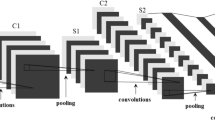Abstract
Amplitude and frequency modulations are still the most popular modulation techniques in data transmission at telecommunication systems such as radio and television broadcasting, gsm etc. However, the architectures of these individual systems are totally different. In this paper, it is shown that a cellular neural network with an opposite—sign template, can behave either as an amplitude or a frequency modulator. Firstly, a brief information about these networks is given and then, the amplitude and frequency surfaces of the generated quasi-sine oscillations are sketched with respect to various values of their cloning templates. Secondly it is proved that any of these types of modulations can be performed by only varying the template components without ever changing their structure. Finally a circuit is designed, simulations are presented and performance of the proposed system is evaluated. The main contribution of this work is to show that both amplitude and frequency modulations can be realized under the same architecture with a simple technique, specifically by treating the input signals as template components.













Similar content being viewed by others
References
Chua LO, Yang L (1988) Cellular neural networks: theory. IEEE Trans Circuit Syst 35:1257–1272
Costantini G, Casali D, Carota M (2005) Detection of moving objects in 2-D images based on a CNN algorithm and density based spatial clustering. WSEAS Trans Circuits Syst 4:440–447
Gonzales RC, Woods RE (2008) Digital image processing, 3rd edn. Prentice Hall, Upper Saddle River
Zou F, Nossek JA (1991) Stability of cellular neural networks with opposite-sign templates. IEEE Trans Circuits Syst 38:675–677
Savaci FA, Vanderwalle J (1993) On the stability of cellular neural networks. IEEE Trans CAS- I: Fund Theo Apps 40:213–215
Pana L, Cao J (2011) Anti-periodic solution for delayed cellular neural networks with impulsive effects. Nonlinear Anal Series B 12(6):3014–3027
Song Q, Cao J (2008) Dynamical behaviors of discrete-time fuzzy cellular neural networks with variable delays and impulses. J Franklin Inst 345(1):39–59
Özmen A, Tander B (2006) A numerical method for frequency determination in the astable cellular neural networks with opposte-sign templates. SİU’06 IEEE 14th Signal Processing and Communication Application Symposium, Antalya, Turkey
Tander B, Ün M (2000) Generalized PSPICE and SIMULINK models for the continious-time simulations of cellular neural networks. BCSP’00, 1st IEEE Balkan Conference on Signal Processing, Communications, Circuits and Systems, Istanbul, Turkey
Oppenheim AV, Willsky AS, Nawab H (1997) Signals and systems, 2nd edn. Prentice Hall, Upper Saddle River
Tander B, Özmen A (2012) Amplitude and frequency modulation behaviours of cellular neural networks. INISTA’2012: The 6th International Symposium on Innovations in Intelligent Systems and Applications, Trabzon, Turkey
Tander B, Baskan M, Senol C (2002) Experimental analysis of transients in small scaled cellular neural networks. ELECO’02: 4th Electrical, Electronics, Computer Engineering Symposium, Bursa, Turkey
Tander B, Ün M (2000) Diode Bridge Clipper as an activation function circuit at the PSPICE simulations of cellular neural networks. ELECO’00: 2nd Electrical, Electronics, Computer Engineering Symposium, Bursa, Turkey
Tander B, Özmen A, Özcelep Y, Design and implementation of a cellular neural network based oscillator circuit. CSECS’2009 The 8th WSEAS International Conference on Recent Advances in Circuits, Systems, Electronics, Control and Signal Processing, Tenerife, Spain
Tander B, Özmen A, Özcelep Y (2010) Design and implementation of a negative feedback oscillator circuit based on a cellular neural network with an opposite sign template. WSEAS Trans Circuits Syst 9:60–69
FCC: Federal Communications Commission Ofice of Engineering and Technology Policy and Rules Division, FCC Online Table of Frequency Allocations, 47 C.F.R. 2.106, 2010
Author information
Authors and Affiliations
Corresponding author
Rights and permissions
About this article
Cite this article
Tander, B., Özmen, A. Amplitude and Frequency Modulations with Cellular Neural Networks. Neural Process Lett 41, 259–272 (2015). https://doi.org/10.1007/s11063-014-9344-y
Published:
Issue Date:
DOI: https://doi.org/10.1007/s11063-014-9344-y




